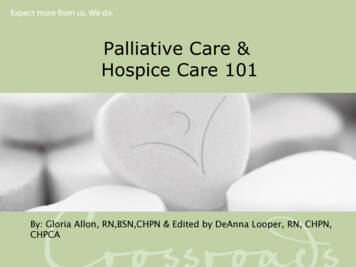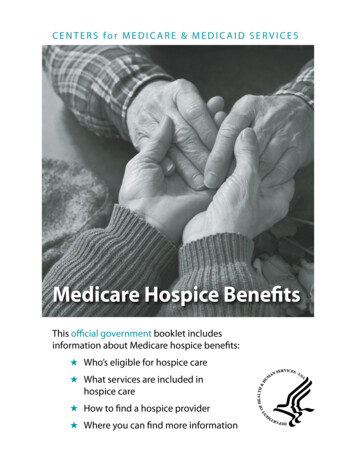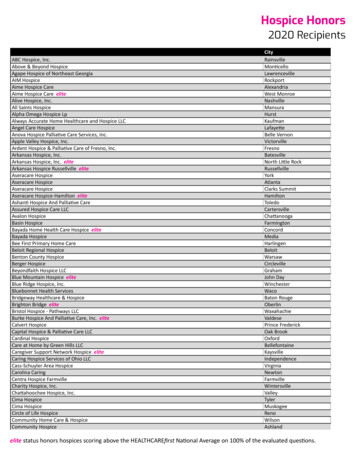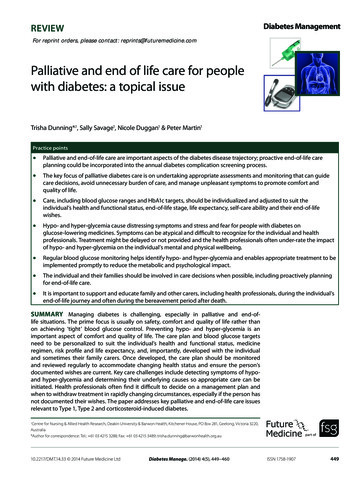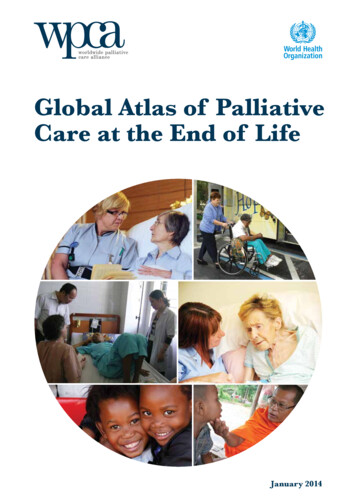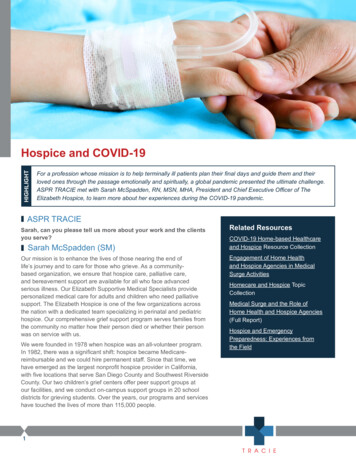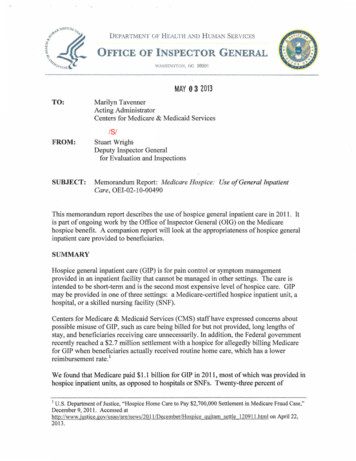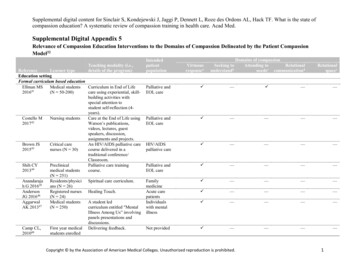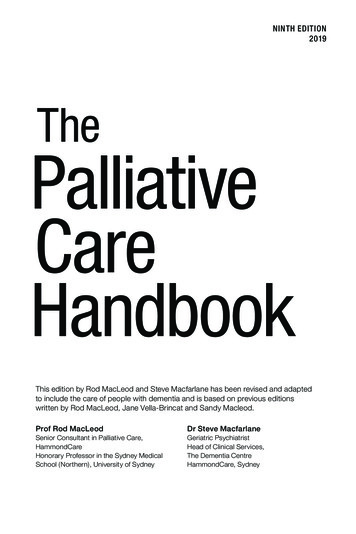
Transcription
NINTH EDITION2019ThePalliativeCareHandbookThis edition by Rod MacLeod and Steve Macfarlane has been revised and adaptedto include the care of people with dementia and is based on previous editionswritten by Rod MacLeod, Jane Vella-Brincat and Sandy Macleod.Prof Rod MacLeodDr Steve MacfarlaneSenior Consultant in Palliative Care,HammondCareHonorary Professor in the Sydney MedicalSchool (Northern), University of SydneyGeriatric PsychiatristHead of Clinical Services,The Dementia CentreHammondCare, Sydney
AcknowledgementsWe are grateful to Hammond Care and Professor Rod MacLeod for supporting thepublication in New Zealand.The organ failure at the end-of-life section and much of the drug interaction data isbased on part of the Canterbury District Health Board’s Preferred Medicines List,Antimicrobial Guidelines and Pharmacology Guidelines 19th Ed. 2015Thanks to Dr Helen Lunt for the diabetes section, Dr Elaine Rogers for the cachexiasection and Dr Richard Egan for input into the spirituality section. Nutrition in palliativecare is written by Melissa Scattergood, Clinical Dietitian and the section ondeprescribing by Andriana Colic, Clinical Oncology Pharmacist – Royal North ShoreHospital, Sydney. We are grateful to all for their expertise and to other colleagues atHammondCare who have made helpful suggestions for improvements.Many of the medications listed are being used outside their product licence.Prescription of a drug (whether licensed use/route or not) requires the prescriber, in thelight of published evidence, to balance both the potential good and the potential harmwhich might ensue. Prescribers have a duty to act with reasonable care and skill in amanner consistent with the practice of professional colleagues of similar standing.Thus, when prescribing outside the terms of the licence, prescribers must be fullyinformed about the actions and uses of the drug, and be assured of the quality of theparticular product (www. palliativedrugs.com/ using-licensed-drugs-for-unlicensedpurposes). Prescribers also have a duty to inform patients that drugs are being usedoutside their licence and to inform them of any expected effects and side effects. Carehas been taken to ensure accuracy of information at time of printing. This informationmay change and final responsibility lies with the prescriber. Some medication will incura cost to the user, it is important to consider this before prescribingThis Handbook should be used in conjunction with Therapeutic Guidelines – PalliativeCare – version 3 (Therapeutic Guidelines Limited, Melbourne) where possibleThroughout the book, drugs that are either not available or not funded in New Zealandare marked with *Abbreviationssubcutsubcutaneousbdtwice dailytdsthree times dailyqidfour times dailyCNSLFTsMAOIsNSAIDscentral nervous systemliver function testsmonoamine oxidase inhibitorsnonsteroidal anti-inflammatory drugsPublished with permission from HammondCare by Hospice NZ - Ninth edition - .au Rod MacLeod, Steve MacfarlaneThe moral right of the authors has been asserted.2 THE PALLIATIVE CARE HANDBOOK
ForewordPalliative care has come a long way from the beginnings of the modern hospicemovement in the 1960s and is now widely understood as an essential part of care forthe whole person during life-limiting illness and at end-of-life.Increasingly we are aware of the importance of being able to provide palliative carewhen and where it is needed and this often means involving palliative care earlier in thecourse of illness and not just in hospital or hospice, but at home and in residential care.Alongside these developments, dementia has become a leading cause of death inmany nations, something which is still relatively new to our experience, but which canbe expected to increase.As a result, the interaction of palliative care with the end-of-life needs of a person withdementia has never been more important or prevalent and yet this is not widelyaddressed in literature and clinical support.As the authors of The Palliative Care Handbook (ninth edition) point out, too oftenpeople with dementia miss out on palliative care referrals and treatments that couldmake such a difference for them in their final days.Which is why this new edition is so vital. Not only have the highly regarded clinical andpharmacological guidelines been fully updated, extensive notes and advice have beenincluded for the first time specifically addressing the end-of-life needs of people withdementia.To accomplish this, original author, Prof Rod MacLeod and new author, Dr StephenMacfarlane, have used their extensive expertise and experience to add many importantinsights and guidelines for palliative care in the context of dementia.There is no doubt that this new edition of The Palliative Care Handbook will continue tosupport excellence in palliative care around the world and now also support a growingawareness of the palliative needs of people with dementia.A/Prof Colm CunninghamDirector of the Dementia CentreHammondCareMary SchumacherChief ExecutiveHospice New ZealandTHE PALLIATIVE CARE HANDBOOK 3
ContentsIntroduction.6Palliative care aims.8Section 1: Symptom control. 9–84Central nervous system.9Dementia. 9Depression. 12Delirium. 15Disorders of sleep and wakefulness. 18Insomnia. 18Drowsiness/hypersomnia. 19Sleep phase (circadian) disorder. 19Terminal agitation. 20Palliative sedation. 21Fear and anxiety. 21Raised intracranial pressure. 23Convulsions. 24Pain. 25–32Comprehensive assessment. 25Other assessment factors. 26Assessment in the setting of dementia. 26Management. 26Neuropathic pain. 30Gastrointestinal system. 33–42Nausea/vomiting. 33Bowel management. 35Diarrhoea. 37Intestinal obstruction . 38Mouth care. 39Taste alteration. 40Swallowing difficulties. 41Malignant ascites. 42Respiratory system.43–48Dyspnoea (breathlessness). 43Cough. 45Hiccup. 46Excessive (retained) secretions. 47Haemoptysis. 484 THE PALLIATIVE CARE HANDBOOK
Skin. 49–53Itch (pruritus). 49Sweating. 50Pressure injury care. 51Lymphoedema. 52Fungating wounds and tumours. 52Systemic effects of terminal diseases.54–66Paraneoplastic syndromes. 54Venous thromboembolism. 55Weakness/fatigue. 56Cachexia. 58Anaemia. 59Hypercalcaemia of malignant disease.60Nutrition in palliative care. 61Organ failure. 62Renal failure. 62Hepatic failure. 63Cardiac failure. 63Deprescribing in palliative care. 64Palliative care emergencies. 67–68Haemorrhage. 67Spinal cord compression. 68Miscellaneous. 69–77Diabetes, hyperglycaemia and hypoglycaemia. 69Diabetes. 69Hyperglycaemia. 70Hypoglycaemia. 72Using steroids. 73The last days or hours. 74Palliative chemotherapy. 76Complementary and alternative medicine. 77Psychosocial/spirituality. 78–87Quality of life. 78Spirituality. 79Advance care planning (ACP) and Advance directives (AD). 81Grief and loss. 83Section 2 : Drug information and syringe drivers.85-161Pharmacopoeia. 85Syringe drivers. 158Syringe Driver Compatibilty Table. 160Useful resources. 162Further reading. 164THE PALLIATIVE CARE HANDBOOK 5
IntroductionWelcome to the ninth edition of The Palliative Care Handbook. This edition has beenextensively revised and for the first time includes specific guidelines to informmanagement of the provision of palliative care services to those living with dementia.Dementia is now the leading cause of death for women in Australia (secondleading cause overall) and a number of other Western countries. Yet the rates ofreferral of those with dementia to palliative care or hospice services remain very low,with most dying either in hospital wards or in aged care homes. Even when it hasbeen recognised that a person with dementia has entered the dying phase, thosewith dementia are significantly less likely to receive palliative medications,including analgesia.It is unclear whether this data reflects a lack of comfort that palliative care professionalshave in working with people with dementia, or ignorance around the issues that thosedying with dementia might face – research in the area is sorely lacking. What is known,however, is that the health needs at the end-of-life for those with dementia arecomparable to the needs of those dying from cancer.Part of the problem may lie in the difficulties health professionals experience indetermining the prognosis of a person with dementia. The average duration betweenthe diagnosis of dementia and dying from dementia is around 10 years, and evenpeople with advanced dementia might, by the time they enter this stage of illness,survive another 2 or 3 years. In one study, only 1.1% of residents with advanceddementia were perceived to have a life expectancy of 6 months or less, yet 71% diedwithin this time. A failure to recognise the onset of the dying process in a person withdementia exposes them to unnecessary investigations, hospital admissions, medicalprocedures and prescription of psychotropic drugs, whilst depriving them of moreappropriate palliative interventions.Regardless of the low rates of referral to palliative care of those with a primarydiagnosis of dementia it is undeniable that, as the population ages, palliative careservices will increasingly encounter patients for whom dementia is a significantcomorbidity that will impact upon their management in a palliative care setting.It is timely, then, for issues related to dementia to assume a greater importance withinthe palliative care sphere. It is hoped that this edition of The Palliative Care Handbookmight be a step towards this.6 THE PALLIATIVE CARE HANDBOOK
The first section of this book is a set of guidelines for the alleviation of symptomscommonly encountered in palliative care. Drug therapy is included.The second section (the pharmacopoeia) contains drug information: It is in alphabetical order by generic drug name. The interactions listed include discussion about enzymes responsible for drugmetabolism commonly known as Cytochrome P450 (CYP) enzymes. There aremany CYP enzymes some of which are genetically controlled. The interactionslisted are based mainly on theory, are subject to change as more is learnt aboutthe CYP enzyme system and are meant to be used as a guide only to potentialinteractions. Only commonly used palliative care drugs have been included butinteractions with other drugs may also occur. There is also information about the use of syringe drivers.While drug information in this book relates primarily to availability in Australia and NewZealand, the medications will generally be available in the UK, US and internationally.Where needed, further information is available from your nation’s regulatory agencye.g. the UK Medicines and Healthcare Products Regulatory Agency and the US Foodand Drug Administration.THE PALLIATIVE CARE HANDBOOK 7
Palliative care aims to achieve the best possible quality of life for patients and their families to understand and address patients’ physical, psychological, social and spiritualsufferingto be applicable from early on in the course of the illnessThe World Health Organisation defines palliative care as:‘An approach that improves the quality of life of patients and their families facing theproblems associated with a life-threatening illness, through the prevention and reliefof suffering by means of early identification and impeccable assessment andtreatment of pain and other problems, physical, psychosocial and spiritual.’Palliative care: provides relief from pain and other distressing symptoms affirms life and regards dying as a normal process intends neither to hasten or postpone death integrates the psychological and spiritual aspects of patient care provides support to help patients live as actively as possible provides support to the family during the illness and bereavement uses a multidisciplinary team approach enhances quality of life and influences the course of the illness is applicable early in the course of illness alongside therapies that are intended toprolong life (e.g. chemotherapy, radiotherapy) and diagnostic investigationsGeneral symptom management principles accurate and meticulous assessment is essentialassess and address non-physical as well as physical issuesdifficult to control symptoms may require several different approachesaim for highest possible quality of lifeuse risk versus benefit assessments when side effects of therapy occurexplain issues as much as possible to the patient and their carersuse a multidisciplinary approachreassess continuously8 THE PALLIATIVE CARE HANDBOOK
Central nervous systemDementia.Dementia is an insidious, global deterioration of cognition without impairment ofconsciousness. More than 100 causes are recognised, though most of these areexceedingly rare: a terminal disease (albeit slow) with a median survival of 7 to 10 years postdiagnosis prevalence of 10% in over 65-year-olds, 20% in over 80-year-olds, 40% in90-year-olds, and for indigenous Australians the prevalence is 3 to 5 times thatof non-indigenous Australians About 1% of all dementia is considered early-onset (age 65). In indigenousAustralians, early-onset disease is defined by an age of onset 50 yearsTypes Alzheimer’s is the most common (70% of all dementias)–– predominant early deficits are episodic memory and orientation to time.vascular (30% of all dementias)–– accompanies a history of cardiovascular events (CVA/TIA)–– islets of retained functioning–– language is preserved–– dysexecutive syndrome–– gait disturbance–– subcortical signs frontotemporal (FTD – 10% of all dementias; commonest cause of early-onsetdisease)–– can occur in those with Motor Neurone Disease (10 to 15%)–– disinhibition, apathy and loss of empathy–– hyperorality, lability, poor insight and compulsive, perseverative behavioursLewy body dementia (LBD)–– Parkinsonism–– visual hallucinations and cognitive fluctuations–– cognitive fluctuations typically marked–– REM-Sleep behaviour disorder–– vulnerability to delirium–– extreme sensitivity to antipsychotics – quetiapine is the agent of choice.treatable causes–– depressive pseudodementia–– subdural and hypothyroidism–– B12 /folate deficiency–– syphilisTHE PALLIATIVE CARE HANDBOOK 9
others–– Parkinson’s disease (essentially very similar to Lewy body dementia),Huntington’s, alcoholic, post traumatic brain injury, paraneoplastic, postencephalitic Note that mixed types of dementia become increasingly common with age, and thatend-stage dementia (regardless of cause) tends to assume a common phenotype.With the exception of Lewy body dementia, determining the exact type of dementia ina palliative/end-stage setting is much less important than recognition and appropriatetreatment of a behavioural syndrome.Assessment ake an extensive history (in end-stage dementia this will invariably need to beTfrom a family member or close caregiver). Formally assess mental state, including the use of cognitive screening tools e.g.Mini-Mental State Examination (MMSE), Montreal Cognitive Assessment (MoCA)- where the patient retains verbal skills. (see ‘Useful resources’ p. 162) In many cases a formal cognitive evaluation will not be possible in advanceddementia, but the broader mental status examination remains invaluable,particularly in relation to:–– General appearance and behaviour. Is the patient agitated, distressed,vocalising? Are there any signs of drug side effects (Parkinsonian facies,resting tremor, dyskinetic movements - oro-lingual dyskinesias are particularlycommon), dystonic reactions, motor tics or perseveration?–– Affect - does the patient’s expression reflect sadness, anxiety, anger?Are they guarded and suspicious? Lability may reflect frontal involvement,and should be differentiated from depression.–– Perception. Does the person appear to be responding to external stimuli?Behavioural and Psychological Symptoms of Dementia (BPSD) delirium–– a careful history is vital. The biggest single risk factor for delirium is thepresence of pre-existing cognitive impairment, so those with dementia are atvastly increased risk. Reduced cognitive reserve lowers delirium threshold.–– A history of acute deterioration (cognitive, functional, behavioural) in thesetting of previously stable impairments should always suggest delirium,and should be treated as such.depression (treat early initially with a SSRI or mirtazapine)–– this is a difficult diagnosis to make in the presence of advanced dementia,where the patient’s ability to report symptoms accurately is compromised–– clinicians are advised to fall back on the presence of ‘hard-core’ biologicalsymptoms of depression in this setting (recent change in sleep or appetitepatterns, complete anhedonia, self-harm behaviour)–– if there is any doubt, erring on the side of a trial of treatment is often advisable.Depression should be on the list of differential diagnoses for most behaviouraldisturbances in dementia, and modern antidepressants are much less toxicthan the antipsychotic drugs that might otherwise be prescribed10 THE PALLIATIVE CARE HANDBOOK
–– irtazapine is a useful drug in this patient group. It has beneficial effects onMsleep, appetite and anxiety that occur early in the course of treatment andwhich are independent of its antidepressant effects–– The minimum antidepressant dose of mirtazapine is 30mg. If treatingdepression there is generally no advantage to commencing at a lower dose(often justified on the basis of minimising sedation mirtazapine is an inverseagonist at the histamine receptor, however, and thus is more sedating atlower doses) agitation/aggression (consider low dose short term antipsychotics,benzodiazepines)–– identify precipitants (can be difficult)–– avoid confrontation–– if the issue is agitation alone, antipsychotics hold no advantage overbenzodiazepines, and are considerably more toxic–– an intermediate half-life benzodiazepine with no active metabolites (e.g.oxazepam 7.5-15mg, temazepam 10mg) is the safest choice–– there is evidence for the use of low-dose risperidone in the managementof aggression, but the effect size is small ( 0.2)anxiety–– peaks in early/mid stagesdelusions (treat with antipsychotic)–– particularly paranoid–– beware ‘delusions of theft’ and ‘misidentification delusions.’ These may wellbe beliefs that have arisen as the artefact of cognitive impairment and/or toreflect neurological impairment (e.g. prosopagnosia) and are not likely to beantipsychotic responsivehallucinations–– visual (up to 50% in LBD, although 20% of Alzheimer’s patients will hallucinateat some stage during the course of the disease)sleep/wake cycle reversal/sundowningloss of insight/judgementwandering (60% of patients)–– pacing and lapping (exclude akathisia)–– (dangerous) eloping i.e. getting lost, accidentsrejection of care–– of food, hydration (consider artificial hydration) and hygieneComplications eating and swallowing difficulties, cachexiainfections – pneumonia, urinary tract–– in pneumonias, the mortality is sevenfold that of a non-dementia patient–– treat if symptomatic, antibiotics have limited efficacyfalls – due to impulsivity, frailty, benzodiazepines and other sedativespain – common in very elderly (50%)–– may present behaviourally (non-verbally, crying, irritability)THE PALLIATIVE CARE HANDBOOK 11
–– r oughly 70% of patients with significant BPSD are likely to have under-treatedor unrecognised pain as a contributing factoradverse reactions to drugs–– antipsychotics – sensitivity (Lewy body disease), parkinsonism, akathisia,acute dystonic reactions, sedation, peripheral oedema, chest infections,accelerated cognitive decline, stroke risk (3 fold that of non-dementiapatients, 1.5 fold mortality), hypotension–– benzodiazepines – sedation, fallsTreatmentAs curative treatment does not exist, ensure that end-of-life discussions/advancedirectives/appointment of enduring power of attorney all happen early before lossof capacity. The environment of care is important – it should be simple, safe, involveattentive and patient staff, include support and education for family and carers,person-centred, proactive, include distractions, activities, routine, memory cuesand benign paternalism. Mild – cholinesterase inhibitors may have temporary cognitive benefit Moderate – focus on quality of life and maintenance of function Severe – maximise comfort, avoid aggressive, burdensome or futile treatments,avoid enteral tube nutrition, consider a secure facility, allow a natural death (AND)Depression.In end-of-life care it is important to distinguish between clinical depression andprofound sadness. depression is a pervasive sense of misery sadness is a normal response to loss which waxes and wanes but enjoyment andfuture planning are retained most terminally ill patients do not become clinically depressed prevalence is about 15% (compared with 5 to 10% in the general population),most commonly in the early cancer stages reaching a diagnosis of depression in terminal patients is difficult as the usualphysical symptoms of depression in the otherwise well such as anorexia, weightloss, sleep disturbance are often already present in patients with malignantdisease whether they are depressed or not the psychological symptoms are more discriminative asking ‘Are you depressed?’ provides a bed-side assessment of mood suicide is rare, however, fleeting suicidal thoughts and fluctuating ‘will to live’ incancer patients are common and not necessarily pathological requests for euthanasia and/or physician assisted suicide are more commonalthough, as for suicide, this is not limited to depressed patients clinical depression is under-recognised and under-treated yet it is generally veryresponsive to treatment the cause of depression is unknown but imbalances in neurotransmitters,especially serotonin, in the brain may play a part12 THE PALLIATIVE CARE HANDBOOK
Psychological symptoms of major depression may include hopelessnessanhedonia (loss of pleasure)morbid guilt and shameworthlessness and low self esteemrequest for physician assisted euthanasiapersisting suicidal ideationlowered pain thresholddecreased attention and concentrationcognitive slowingimpaired memoryindecisivenessearly morning wakeningruminative negative thoughtsnihilistic and depressive delusionsfeeling of unrealityDepression in older people and people with dementiaIt is worth noting that the ‘textbook’ symptoms of major depression as they appearin references such as DSM-
The first section of this book is a set of guidelines for the alleviation of symptoms commonly encountered in palliative care. Drug therapy is included. The second section (the pharmacopoeia) contains drug informa
